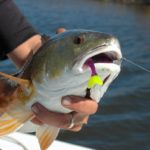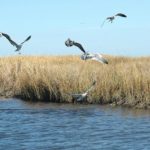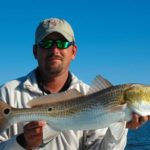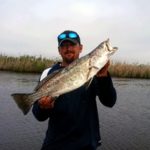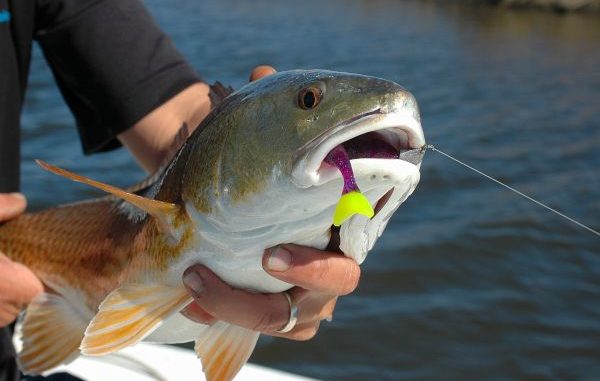
Sabine Lake produces some of the most-striking reds in the Bayou State. Here’s how to put some of these copper-hued fish in the boat.
“There’s some fish moving on that cut over there,” said Capt. Robby Trahan, pointing to a finger bayou coming out of the marsh on Sabine Lake’s northeastern edge. “They’re going down these banks right now because there’s a lot of bait in here.”
Sure enough, the body of a redfish suddenly vaulted out of the waters at the mouth of the cut. The fish was not by itself, however, as the backs and tails of others followed in its wake.
“They’re working the bait so well they actually have the water muddied up there a good bit along the banks,” the 35-year-old angler from Johnson Bayou said.
Trahan initially missed the first hit on his LSU Wedgetail Mullet, but he didn’t make the same mistake on the followup strike.
“I got him. Yeah, it’s a red,” he said as his drag screamed in spurts and his braid metered off the reel.
The fish made a few good thrusts as Trahan reeled him back to the boat.
“He’s a toad — a slot fish fatter than I thought,” the angler said after hoisting it to the deck with his rod arching a tad too close to breaking.
A close inspection of the fish placed its length at approximately 22 inches.
Some 20 minutes later, Trahan’s boat motored out of the marsh canal and onto the eastern edge of the lake. Gulls were flying in a few locations, and Trahan was casting the LSU wedgetail again — this time under the birds.
“There’s one,” the angler said. “And it’s a good one. He swallowed that bait.”
Once netted, the 27-inch redfish was closely inspected. It had shrimp whiskers protruding from the frontal interior of its gullet.
We went on that day to catch, photograph and release at least 12 redfish and about 15 speckled trout.
But we were there primarily for the Sabine gold — schools of voracious redfish that prowl the lake and interior marshes to the north and east of the 90,000-acre waterway sitting on the eastern edge of Cameron Parish and bordered by Port Arthur, Texas, to the west.
And it’s during mid-August through October when these bronze beauties school up, chiefly due to Mother Nature’s call to spawn.
And they gorge on baitfish, crabs and shrimp flooding out of the marsh and into the edges and central portions of the lake.
“It’s not unusual to see hundreds of redfish schooling and rolling together in the mid-lake in August and into the fall months,” said Trahan. “Heck, there\’ll be acres of them at times.”
Kent Carlson of Johnson\’s Bayou, another Sabine Lake guide (K&J Hunting and Fishing Lodge), echoed Trahan’s observations but added another.
“There will also be huge pods of big bull reds popping up every now and then from a quarter to a half mile offshore,” the 47-year-old Carlson said. “Sometimes there’ll be an acre of these chasing and eating on schools of pogies.”
Trahan said redfish will also be chasing pogies and shrimp out of the eastern Sabine Refuge Marsh on the Louisiana side and into the main lake.
Fishing for this species just simply gets outright phenomenal at Sabine Lake this time of the year.
Recently, Trahan and his 15-year-old son Nolan caught a copper-toned red as one of four fish weighing 30.15 pounds to win the 2013 Do It in Orange Fishing Classic out of Orange, Texas.
“We have so much influence from the Sabine River,” said Trahan.
For that reason, the marshes stay fresher, and they become brackish, clear and black — producing redfish that literally glow.
“I think it’s because of the clear water in the marshes that these redfish always retain that copper and gold color,” he said. “The fresher the water, the golder they appear to be.
“And they keep that color when they get out into the main lake.”
Carlson added another reason for the freshwater flow effect into the Sabine Lake estuary.
“The estuary is not closed up, nor are there any dams,” said Carlson.
Since Sabine Lake is fed by the Neches and Sabine rivers, its waters are more of a natural estuary, with the flow from these rivers pushing into the vast marshes on the Louisiana side.
“The jetty redfish and those taken on the beaches east and west of the jetties are much lighter in color by comparison,” said Trahan.
On our trip, Trahan spent a lot of time early in the morning sight-fishing in the many bayous and marsh cuts that enter Sabine Lake.
“This is probably one of my favorite things to do,” he said. “I can see some now, tailing in the waters on that eastern edge of that bank.”
Trahan cruised the bank with his trolling motor on low while keeping the wakes from the redfish clearly in his sight.
“Redfish will throw a steady, big wake right underneath the surface, whereas the big garfish in here will keep closer to the bottom and kick up more mud,” he explained.
There’s another tip-off.
“I am also looking for gulls in here, as they will stay on top of the schooling reds,” Trahan said. “They’ll be hovering over the schools of reds that are feeding, especially on shrimp.”
Pointing to a corner, Trahan described a school of about 10 redfish feeding near a point of the marsh bayou.
“All their backs are above the water, and you can see them in the shaded area of that corner,” he said. “Look: There’s some now busting the surface.”
Trahan said he was going to get as close as he could to them and then cut the trolling motor off.
“There’s a smaller group of them chasing shrimp to the side of the larger school,” he said. “There must be shrimp pushed up along the bank because of all these redfish, and now I’m going to cast to the fish to see if we can get one or two.
“Those fish are in less than a foot of water along those banks.”
Trahan cast a purple/chartreuse wedgetail mullet on a ¼-ounce jighead with no cork to the bank.
As he worked the bait, Trahan admitted that the LSU color works really well in the very lightly stained waters moving along the Sabine marsh edge.
His cast was too short, but Trahan’s second cast proved to be accurate.
“The fish is on,” said Trahan.
Again, the drag screamed and the fish was taking braid.
The fish moved to the top of the water column repeatedly and caused quite a disturbance.
“That\’s what\’s so fun,” Trahan said as he reeled in the chubby marsh red. “You can get so excited, just pumped up watching them when you see that wake.
“And in this shallow water, they really give you a fight that you can see.”
As morning shadows disappeared, Trahan switched ton a LSU wedgetail under a cork, and several more marsh slot reds were taken.
On another rod, Trahan also threw a favorite topwater for these fish — a Heddon Spectrum Spook Jr.
As to finding marsh areas to sight-fish, Trahan recommended the eastern marsh complex of the Sabine National Wildlife Refuge on the Louisiana side of Sabine Lake.
However, it’s important to note that the refuge has a fishing season coupled with many specific rules, so review of the regulations pamphlet (which can be downloaded at www.fws.gov/southeast/pubs/swlacomplex_fish.pdf) is in order.
Gulls were flying above the Sabine Lake waters just to the south of where Trahan entered the lake from the bayou on the northeastern end.
Three of the birds had settled down atop the waters, but the others remained in the air.
“There they are,” said Trahan, pointing to the crimson bodies of redfish that would appear briefly on the surface. “They’re working right near those birds.”
He cast the LSU wedgetail without a cork into the vicinity of the birds.
Trahan set the hook as soon as the lure hit the water.
“There’s another one,” he said.
After pictures were taken and the fish was released, Trahan explained his approach to fishing the main lake.
“I’ll find these lake reds working under both flying gulls and also sitting gulls,” he said. “And it can be pretty quick fishing, with fish after fish taken near the birds — especially if the reds are feeding on schools of pogies.”
Of course, reds aren\’t the only predators to be found feeding on the lake.
“There’ll be some really good trout sometimes mixed in, as well,” Trahan said. “My largest trout, taken here in Sabine Lake last August, went 29 inches and was caught during the full moon stage.”
Unlike Trahan, Carlson employs a different approach to fishing for redfish on Sabine Lake during August.
“I’ll start at the south jetties and beachfront,” said Carlson. “I’ll be working the surf on the sandbars initially, and then the jetties.
“At about 10:30 to 11:00 a.m., I\’ll then be in mid-lake looking for slicks, watching for big swells and working the birds. Disturbed waters and lots of bait are my targets for finding redfish.”
As for baits, Carlson uses the heaviest live bait or cut bait for those bull reds just offshore or in the surf.
As he moves into the inland waters, he changes to artificials — with his mainstay Flounder Pounder curly tails.
Editor’s note: Trahan can be contacted at 337-309-7881 or via www.fishingsabinelake.com. Carlson can be reached at 409-460-1819 or online at www.kandjlodge.com.
